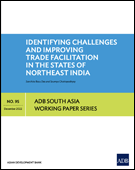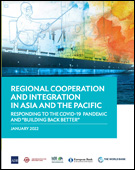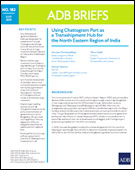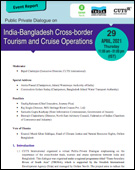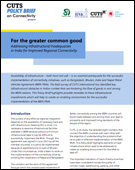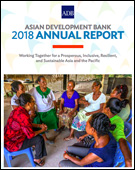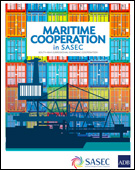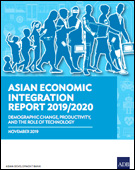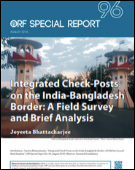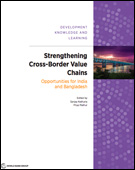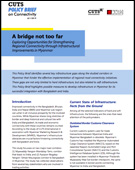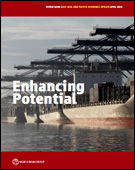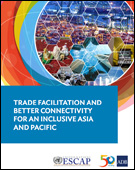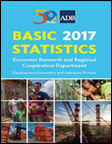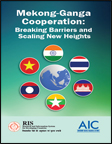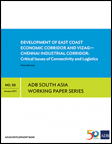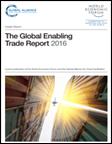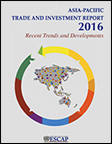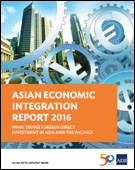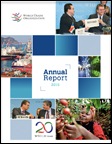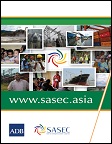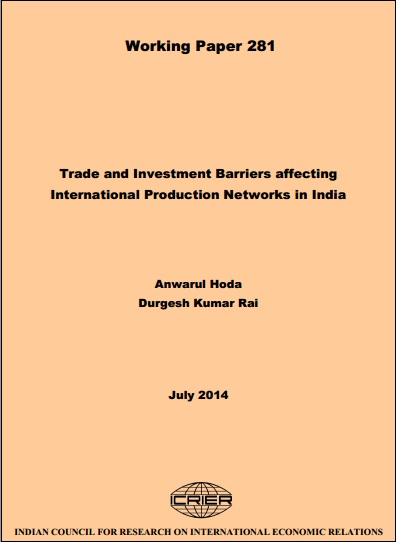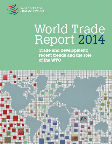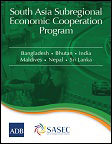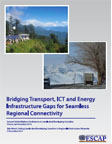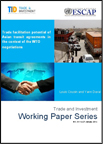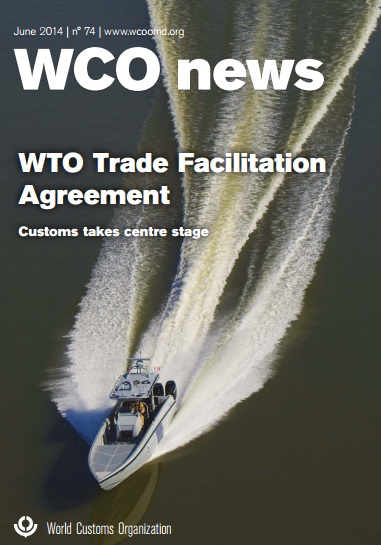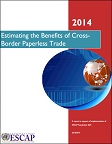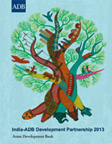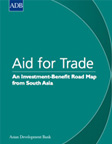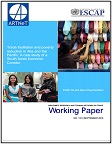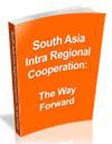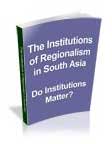Trade Facilitation Results
Trade facilitation focuses on removing barriers to the international movement of goods to lower trade costs, at and around the borders, and along the supply chain, to make countries more competitive in regional and global markets. In the SASEC subregion, bottlenecks in trade facilitation are the leading non-tariff barriers that constrain intraregional trade. SASEC initiatives in trade facilitation aims to make cross-border trade and transport in the subregion faster, cheaper, and more predictable, while maintaining the security of the supply chain and ensuring the effectiveness and efficiency of the institutions involved.
TRANSPORT INDIA
REPORTS
total items: 37The northeast of India is shares international borders with Bangladesh, Bhutan, Nepal, and Myanmar and acts as a bridge for India's participation in global forums through the Bay of Bengal Initiative for Multisectoral Technical and Economic Cooperation and the South Asia Subregional Economic Cooperation program. This paper highlights challenges in global trade and suggests ways for improving trade with other countries in South Asia and Southeast Asia.
Platforms for regional and subregional cooperation helped spur collective action to help Asia and the Pacific build back resiliency from the coronavirus disease (COVID-19) pandemic. Regional cooperation platforms such as the South Asia Subregional Economic Cooperation program helped countries respond to the COVID-19 emergency. In South Asia, partners will have the opportunities to support regional market development through transport corridors, trade facilitation, and cross-border energy trade post-COVID-19.
Source: Asian Development Bank
The brief focuses on developing logistics in India's northeastern region and Bangladesh. To facilitate seamless transshipment movement through Chattogram port, this brief presents a framework to promote sustainable development and suggests ways to address infrastructure and regulatory gaps.
Trade and tourism along transboundary rivers bring socioeconomic opportunities in India and Bangladesh. This report for the webinar "Public Private Dialogue on India-Bangladesh Cross-border Tourism and Cruise Operations" suggests that easing security, customs, and immigration protocols while strengthening safety measures would help ensure that cruise operations are inclusive and sustainable.
Source: CUTS International
Both soft and hard infrastructure are needed to successfully implement the Bangladesh, Bhutan, India, and Nepal Motor Vehicles Agreement (BBIN MVA) and other connectivity initiatives. This field survey report identifies infrastructural gaps in India and suggests possible remedies to help improve flow of goods among the BBIN economies.
Source: CUTS International
The Asian Development Bank (ADB) supports cross-border infrastructure to help foster regional cooperation and integration. It is transforming transport corridors into economic corridors, allowing South Asian countries to participate in regional and global value chains and promote agriculture trade. In 2018, ADB committed $150 million to upgrade sections of South Asia Subregional Economic Cooperation (SASEC) road corridors in India and Nepal. The investments aim to improve connectivity between Manipur (in India) and Myanmar; build an India–Nepal international bridge; and improve the safety of Nepal’s East–West Highway. ADB also approved a technical assistance project to build institutional capacity and improve expertise of trade facilitation officials in SASEC member countries.
Source: Asian Development Bank
Most South Asia Subregional Economic Cooperation (SASEC) countries rely on maritime transport for international trade. Stronger maritime relations are crucial to achieve the economic growth potential for the subregion. This report looks at how countries can strengthen international trade by improving maritime cooperation among the SASEC countries, comprised of Bangladesh, Bhutan, India, Maldives, Myanmar, Nepal, and Sri Lanka. It gives an overview of the SASEC maritime sector and identifies collaboration initiatives that could address key challenges.
Source: Asian Development Bank
This report reviews economic cooperation and integration in Asia and the Pacific. It reports that in 2018, the South Asia Subregional Economic Cooperation (SASEC) focused on reducing gaps in multimodal connectivity among its member countries. By the end of 2018, 52 ADB-financed projects worth $11.36 billion had been committed to SASEC projects, with an additional $106.44 million in 81 technical assistance grants. SASEC nodal officials and working groups met in Singapore in March 2018 to update the SASEC operational plan. The operational plan identified 77 projects ($45.6 billion) to be financed by SASEC members, ADB, and development partners. A holistic approach under the operational plan will build transport links with Southeast Asia and East Asia and expand regional trade markets.
Source: Asian Development Bank
Integrated Check-Posts (ICPs) are designed to be one-stop solutions that house all regulatory agencies, including immigration, customs, and border security. India is in the process of establishing ICPs to efficiently manage crossings along its land borders. The country has identified 20 checkpoints for development as ICPs, including 10 that are on the India–Bangladesh border. This report studies the impact of the ICPs on activities along the India-Bangladesh border and suggests ways to improve efficiency of ICPs.
Source: Joyeeta Bhattacharjee
Infrastructure development in India and connectivity agreements with Bangladesh help unlock the economic potential of India’s northeast region. This report analyzes value chains of fruits and vegetables, spices, bamboo and related products, and medical tourism, and identifies how Bangladesh can benefit from northeast India’s increasing connectivity and growth prospects.
This policy brief explores these two corridors in Myanmar: the Myawaddy-Yangon-Mandalay-Tamu corridor to India and the Pyarpon-Bogalay-Yangon-Sittwe-Maungdaw corridor to Bangladesh. It identifies possible infrastructure development that would help integrate Myanmar with Bangladesh and India.
Source: CUTS International
East Asia and Pacific (EAP) grew slightly faster than anticipated in 2017, with growth in Myanmar rebounding slightly at 6.4% due to strong exports. Amid risks to macroeconomic stability, EAP countries must enhance trade facilitation and integration, improve education systems, and upgrade capabilities of workers and managers.
Source: World Bank
This report investigates the evolution of trade costs, examines trade facilitation and paperless trade implementation, and highlights key initiatives in South Asia, including efforts by members of the South Asia Subregional Economic Cooperation (SASEC). The SASEC Trade Facilitation and Transport Working Group agreed to expand assistance to trade facilitation through technical assistance to support more efficient, transparent, secure, and service-oriented processing of cross-border trade across South Asia. Through 2025, the SASEC connectivity agenda will be better aligned with the frameworks of South Asian Association for Regional Cooperation and the Bengal Initiative for Multi-Sectoral Technical and Economic Cooperation. To help establish a trade and transport facilitation monitoring mechanism, Bangladesh, Bhutan, and Nepal conducted studies that reviewed trade and transport procedures, analyzed bottlenecks, and gave recommendations on trade and transport facilitation.
Source: Asian Development Bank and United Nations Economic and Social Commission for Asia and the Pacific
Basic Statistics 2017 contains development indicators for 45 economies in the Asia and Pacific Region, including the seven SASEC countries, Bangladesh, Bhutan, India, Maldives, Myanmar, Nepal, and Sri Lanka. It includes selected indicators of the Sustainable Development Goals (SDGs) such as the proportion of population living below $1.90 (PPP) a day, proportion of population with access to electricity, renewable energy share in the total final energy consumption, unemployment rate, total official flows for infrastructure, and trade balance.
Source: Asian Development Bank
The Mekong-Ganga Cooperation (MGC) promotes intra-regional collaboration among Cambodia, India, Lao PDR, Myanmar, Thailand and Vietnam in the areas of trade, tourism, culture, education, and transport and communications. This book reviews how MGC cooperation has grown since MGC's inception in 2000, including expansion of their economic and cultural relations. Under India's Act East Policy, MGC has gained further momentum – endorsing a Plan of Action 2016-2018, and planning extended connectivity of the India-Myanmar-Thailand Trilateral Highway to Cambodia, Laos, and Vietnam. This report outlines important discussion points on trade, regional value chains, foreign direct investment, physical and digital connectivity, border connectivity, and cultural relations, to strengthen India and the Association of Southeast Asian Nation linkages through MGC.
Source: Research and Information System for Developing Countries and ASEAN-India Centre
The East Coast Economic Corridor (ECEC)—India’s first coastal corridor—is an integrated economic development initiative that is expected to help pursue industrialization and integrate domestic companies into the global value chains of Southeast Asia and East Asia. Its development will start with Vizag–Chennai Industrial Corridor (VCIC), which covers about 800 kilometers and includes several ports and major industrial centers. This paper discusses strategies to consider when trying to improve shipping and air connectivity in the ECEC and Vizag–Chennai Industrial Corridor (VCIC). It stresses the importance of infrastructure development and regulatory reforms that facilitate increased connectivity.
Source: Pritam Banerjee
The Global Enabling Trade Report has been created to provide insight into trade policy and practice. It includes the Enabling Trade Index (ETI), which assesses the extent to which economies have in place institutions, policies, infrastructures and services facilitating the free flow of goods over borders and to their destination. This edition highlights that while an increasingly globalized trading system has been lifting millions out of poverty, trade barriers and costs are still preventing millions of people around the world from engaging in international trade. It reports that all South Asian economies have improved their ETI score over the past two years, with Bhutan as the most improved country in the region, jumping 12 places to 92, followed by India at 102, Sri Lanka at 103, Nepal at 108, Pakistan at 122, and Bangladesh at 123, yet the region remains the most closed worldwide. While South Asia has improved its access to foreign markets and adoption of ICTs, it needs to improve access to its domestic market – on average, South Asian countries impose a tariff of 16.7% on imported products – and enhance its transport infrastructure, particularly in Bhutan and Nepal.
Source: Global Alliance for Trade Facilitation and the World Economic Forum
The Asia-Pacific Trade and Investment Report 2016 reports that the Asia-Pacific region is still the largest exporter of goods globally, with a share of 40%. Its share in commercial services trade is also on the rise, while restrictiveness of services trade has not increased. Foreign direct investment (FDI) inflows is also growing at a much faster pace compared to the global average, with special economic zones being used as one of the modalities to attract FDI. India, in particular, has been attracting an increasing portion of FDI inflows, both from outside and inside the region. While economies in Asia and the Pacific continue to make progress toward trade facilitation, there are still huge gaps among subregional economies, with much needing to be done to reduce trade costs. Furthermore, efforts undertaken to reduce trade costs through trade facilitation have been partially offset by imposition of a large number of new trade distortive measures globally and regionally, with most of these new measures falling under the non-tariff category.
Source: United Nations Economic and Social Commission for Asia and the Pacific
The 2016 Asian Economic Integration Report reviews regional economic cooperation and integration in Asia and the Pacific, amidst the rising global uncertainty following the United Kingdom’s referendum on leaving the European Union and the U.S. election, slower-than-expected global economic recovery, and ongoing economic restructuring in the People’s Republic of China and growth moderation. Asia faces heightened uncertainty–trade growth decelerated in 2015, falling to 2.3% in 2015; subregional trade linkages continue to strengthen, but inter-subregional trade linkages weakened; and non-tariff measures have become major obstacles to trade. In South Asia, SASEC cooperation has improved access to key markets in smaller economies, reduced real trade costs and behind-the-border barriers to stimulate investment; and enabled cross-border power exchanges to ensure power supply affordability, reliability, and overall grid stability. However, the SASEC agenda needs to be framed within wider integration processes taking place in Asia in the next decade to enhance economic linkages, and harness the full potential of Asian integration.
Source: Asian Development Bank
The World Trade Organization (WTO) Annual Report 2015 provides an overview of WTO activities in 2014 and early 2015. It presents a timeline of two decades of the WTO -- from its origins succeeding the General Agreement on Tariffs and Trade to its current role in the multilateral trading system. It presents a chapter on how WTO helps developing countries build trade capacity and allows them to implement trade agreements. WTO training courses are organized for officials from developing countries each year.
Source: World Trade Organization
This promotional brochure for the SASEC website features the web portal as a one-stop shop for information on SASEC activities, events, projects, and knowledge materials. The SASEC website seeks to build a dynamic discussion platform and repository of data on regional cooperation.
Source: Asian Development Bank
Recognizing India as an outlier in development of international production networks with the lowest participation among Asian countries, this study investigates the reason for India’s lackluster participation in production-sharing networks. Using desk work, field surveys, and interviews, an analysis is adopted with three comparator countries in the region that have been successful in production-sharing arrangements as well as industrial growth – China, Malaysia, and Thailand. It further describes foreign direct investment inflows into India, analyzes behind-the-border investment environment, and provides recommendations to improve investment climate and hasten the pace of manufacturing development in India.
This annual publication highlights the relationship between trade and development, including changes since the start of the millennium. It identifies four key trends that altered the way trade affects development outcomes – accelerated economic growth in developing countries, expansion of global value chains, increase in agricultural and natural resource prices, and global nature of macroeconomic shocks. This report also explores how these trends have reshaped the role of trade in facilitating development and how recent development gains allow developing countries to adapt and mitigate risks.
Source: World Trade Organization
This promotional brochure is a concise introduction to the South Asia Subregional Economic Cooperation (SASEC) Program, highlighting the main areas of regional cooperation and activity. It includes facts and figures about SASEC projects in transport, trade facilitation, energy, and ICT.
Source: Asian Development Bank
This publication is a contribution by the United Nations Economic and Social Commission for Asia and the Pacific to deliberations at the Second United Nations Conference on Landlocked Developing Countries (LLDCs) in Vienna, Austria, 3-5 November 2014. It shows regional connectivity as an unfinished agenda and bridging infrastructure gaps as a complex challenge for LLDCs. While physical infrastructure is a priority, this report argues that deeper regional integration – through regionally cohesive and terrestrial networks – is key to effectively linking Asian LLDCs to the region’s infrastructure networks.
Source: United Nations Economic and Social Commission for Asia and the Pacific
Freedom of transit is an issue critical to landlocked developing countries whose lack of direct access to the sea has increased costs and lessened their competitiveness in international trade. To meet challenges arising from transit barriers, member states of the United Nations Economic and Social Commission for Asia and the Pacific recommend transit facilitation as part of an integrated approach to trade facilitation. This working paper analyzes freedom of transit and transit facilitation in the context of trade and transport agreements in the Asia Pacific region, identifying good practices and weighing in on the extent to which existing agreements meet the provisions on transit facilitation stated in the draft text of the World Trade Organization Agreement on Trade Facilitation.
Source: Louis Cousin and Yann Duval
WCO News is a biannual newsletter of the World Customs Organization (WCO). This issue, released in June 2014, focuses on the World Trade Organization's (WTO) Agreement on Trade Facilitation. WCO's commitment to its implementation is highlighted and linkages between articles of the Agreement and WCO instruments and tools are explored. Also included is a feature on the benefits Authorized Economic Operator programmes bring supply chain companies.
Source: World Customs Organization
Cross-border paperless trade is trade that occurs on the basis of electronic communications and has been part of customs reform efforts in a variety of countries. Increased implementation of cross-border paperless trade is high on the trade facilitation agenda in Asia-Pacific. This report considers six measures to calculate estimates of possible economic benefits of cross-border paperless trade through counterfactual simulations using 2013 data and simple econometric models. Simulation results reveal that this new generation of trade facilitation can significantly reduce trade costs and boost intra- and extra-regional trade in the region. Partial implementation of these measures can lead to an export increase of $36 billion annually. Total direct cost savings across all trade is about $1 billion per annum for partial reform, and $7 billion for full implementation.
Source: United Nations Economic and Social Commission for Asia and the Pacific
This publication showcases how Asian Development Bank (ADB) has been working closely with the Government of India to improve the overall design, delivery, and development effectiveness of ADB's India program.
Source: Asian Development Bank
Aid for Trade (AfT) came to prominence just over a decade ago at the launch of the World Trade Organization's Doha Round. With its focus on helping least developed countries and economies escape the poverty trap, it aims to strengthen their capabilities to meet market demand and to reduce supply-side constraints such as a lack of trade infrastructure.
Source: Asian Development Bank
ADB's third Regional Cooperation Operations Business Plan (RCOBP) 2014-2016 for South Asia under its South Asia Regional Cooperation Strategy (RCS) 2011-2015 details a cumulative indicative lending program of $3.3 billion and maintains focus on improved regional connectivity, increased cross-border trade, and strengthened regional economic cooperation.
Source: Asian Development Bank
This study assesses the potential impact of trade facilitation on poverty reduction in the region under SAARC Corridor 1, which is one of the leading corridors in South Asia and handles overland trade between Bangladesh, India and Pakistan. Poverty reduction depends on decreasing trade barriers through better trade facilitation and improved infrastructure.
Sector roadmaps with result frameworks for transport, energy, and trade facilitation.
Source: Asian Development Bank
This study aims to showcase the benefits of regional integration and recommends strategies for overcoming the many hurdles.
Source: Shahid Kardar
This paper assesses the contribution of key institutions of regional cooperation and integration (RCI) in South Asia, and suggests ways in which the Asian Development Bank and other development partners can strengthen their support. It attempts to enhance understanding on the interplay between politics and RCI, including how good bilateral political relations or improvements have advanced RCI. With the overall political environment growing increasingly open to RCI, the paper suggests the time has come for the South Asian Association for Regional Cooperation (SAARC) to consider strengthening the capacity of the SAARC Secretariat to meet the growing challenges and work load of managing the anticipated increase in RCI.
Source: Prabhu Ghate
This report reviews the provision of high priority regional public goods (RPGs) selected for the South Asia subregion, and proposes areas of cooperation for improving the provisioning of RPGs in South Asia. It highlights the issues in cross border management of infrastructure projects and best practices in the provisioning of RPGs relevant for South Asia, evaluates ADB’s contributions to providing RPGs in the subregion, and concludes with recommendations on ADB’s South Asia Regional Department’s role in the provision of RPGs in the subregion.
Source: Khaja Moinuddin
This paper examines the benefits of regional cooperation and integration, focusing on the cost of neglecting to address the binding constraints to regional cooperation and integration. Component papers in this volume analyze the current state of play, and identifies the binding constraints to achieving more efficient transport corridors, regional energy trade and trade facilitation in the region.
Source: Gilberto M. Llanto

